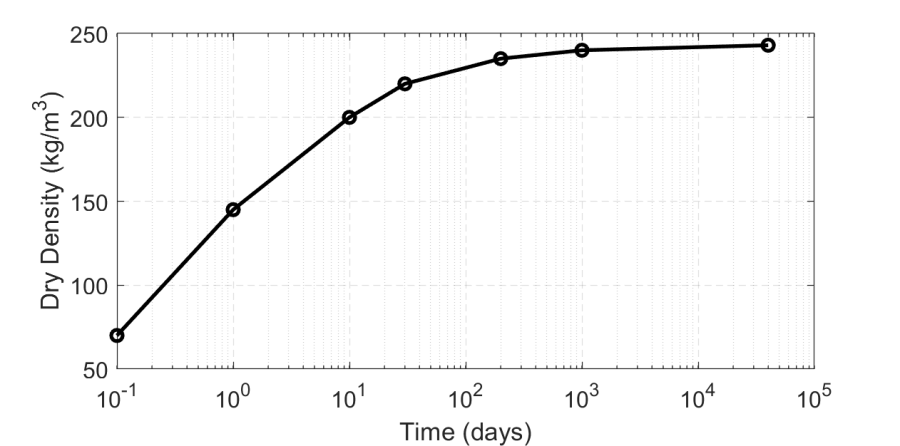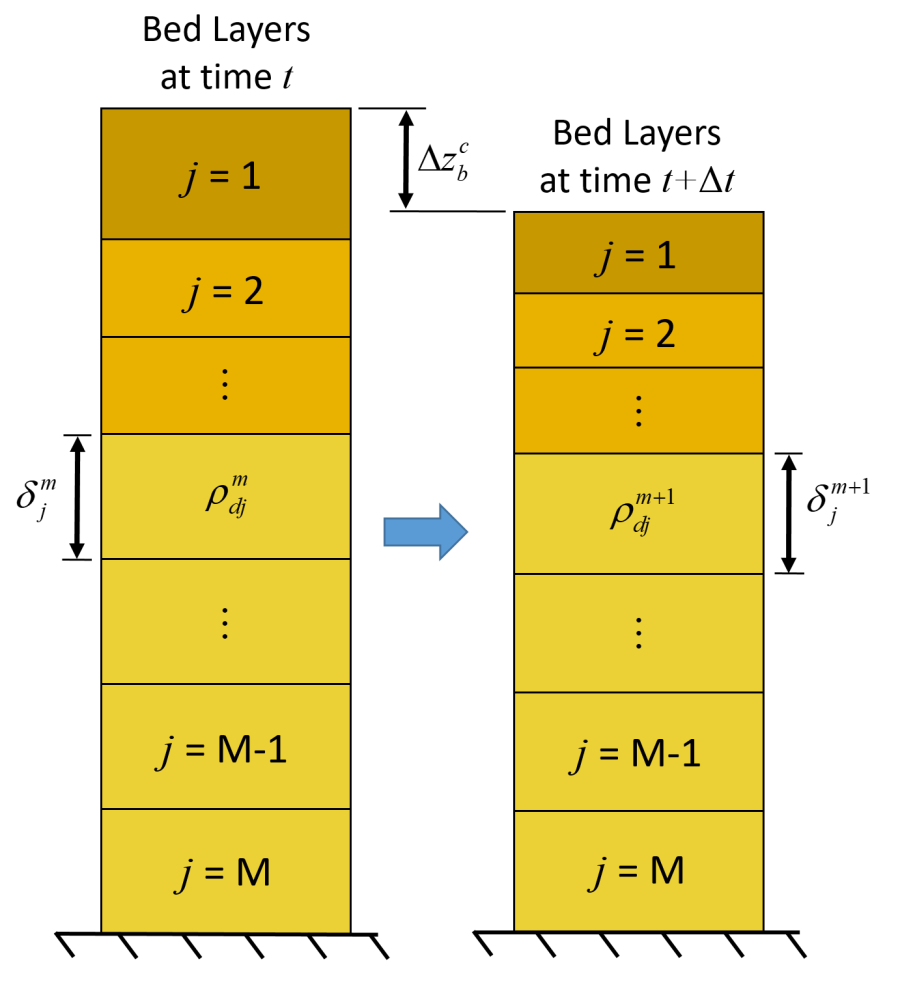The bed elevation is adjusted for subsidence and consolidation as
| 1) |
z_{bi}^{m+1}=z_{bi}^{m}+\Delta z_{bi}^{s}+\Delta z_{bi}^{c} |
where
\Delta z_{bi}^{s} = bed change due to subsidence [L]
\Delta z_{bi}^{c} = bed change due to consolidation [L]
The calculation of each subsidence component and the modification of bed layer thickness and dry bulk density is described below.
Subsidence
The subsidence for every time step is computed as
| 2) |
\Delta z_{bi}^{s}=-\Delta tS_{R} |
where \Delta t is the time step and SR is a user-specified subsidence velocity which is specified as a time series.
Consolidation
Consolidation is computed utilizing a user-specified curve of dry bulk density as a function of time. Below is an example of a consolidation curve.

Figure 3 29. Example consolidation curve of dry bulk density as a function of time.
A schematic of the consolidation computation for a single time step is shown in the figure below.

Figure 3 30. Schematic of the multiple layer bed consolidation.
The change in the bed layer dry bulk density is calculated using the following semi-analytical scheme
| 3) |
{t_{ji}}^m = f^{−1}({ρ_{dji}}^m) |
| 4) |
t_{ji}^{m+1}=t_{ji}^{m}+\Delta t |
| 5) |
ρ_{dji}^{m+1} = f\left({t_{ji}}^{m+1}\right) |
The interpolation of the dry densities and times from the consolidation curve is done with logarithmic interpolation. The dry bulk density is computed at m+1, the bed layer thickness and fractional mass concentrations are updated as
| 6) |
\delta _{ji}^{m+1}=\frac{\rho _{dji}^{m}\delta _{ji}^{m}}{\rho _{dji}^{m+1}} |
| 7) |
m_{jki}^{m+1}=\frac{m_{jki}^{m}\delta _{ji}^{m}}{\delta _{ji}^{m+1}} |
The total shallow subsidence due to consolidation is therefore the sum of the bed layer thickness change
| 8) |
\Delta z_{bi}^{c}=\sum _{j=1}^{M}\left(\delta _{ji}^{m+1}-\delta _{ji}^{m}\right) |
where M is the total number of shallow bed layers. Consolidation is computed at all computational cells with cohesive sediments whether they are submerged or unsubmerged.
It is important to understand that the time here does necessarily match the time at which the sediment was deposited, since the dry density of deposited sediments can be larger than the dry density in the user-defined as at time zero, especially if the deposited sediments include coarser material. Therefore, the time should be viewed as a relative time which does not necessary start at zero.
Alhtough an algorithm could be conceived in which the consolidation times are saved, which would save the the first step above, the approach would not work for the first and second layers because their dry densities are affected by erosion, deposition, and mixing. The current approach has the advantage of treated all layers the same. Noncohesive sediments increase the dry bulk density of mixture and also reduce the ability of soil to consolidation under self weight. Since the presense of noncohesive sediment fractions have a big impact on the overall dry bulk density of the material, the dry bulk density of cohesive/noncohesive sediment mixtures usually result in consolidation times which are beyond the user-specified consolidation curve and therefore resulting in zero consolidation. If the initial dry bulk density is higher than the highest value on the consolidation curve, consolidation is not computed.